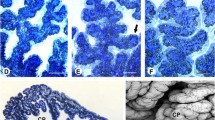Abstract
The pre- and postnatal development of the chamber angle region was studied in the rat. The eyes of five weight-matched littermates were investigated by light- and electron microscopy at each of the following times: prenatal days 14, 17, 18, 21; day of birth; postnatal days 5, 10, 15, 20, 40, 60, 100, 200. Major developmental stages are demonstrated and the morphological characteristics of each stage shown. Developmental periods in the rat are correlated with periods that have previously been outlined in the human (Remé and Lalive 1981). Major periods comprise the following events: I. anlage formation (day 17 prenatal — day 5 postnatal); II. differentiation into definitive structures (days 5–10); III. specialization of definitive structures (days 10–20); IV. final components (days 20–60); V. final molding and rarefaction (days 60–100). Our data indicate that the developing rat eye is a suitable experimental model for studies on the development of the chamber angle. Moreover, this study provides baseline data for a separate investigation on morphogenetic events contributing to the remodeling processes occurring within the vertebrate chamber angle.
Zusammenfassung
Die prä- und postnatale Entwicklung der Kammerwinkelregion der Ratte wird untersucht. Die Augen von 5 gewichtsgleichen Tieren eines Wurfes werden zu jedem der folgenden Zeitpunkte licht- und elektronen-mikroskopisch analysiert: Pränatale Tage 14, 17, 18, 21. Tag der Geburt. Postnatale Tage 5, 10, 15, 20, 40, 60, 100, 200. Wichtige Entwicklungsstadien werden herausgearbeitet und ihre morphologischen Charakteristika dargestellt. Die genannten Entwicklungsstadien der Ratte werden mit Entwicklungsstadien des menschlichen Kammerwinkels verglichen, die in einer früheren Arbeit beschrieben worden sind (Remé und Lalive, 1981). Die Hauptstadien umfassen folgende Entwicklungsschritte: I. Anlage der Kammerwinkelbestandteile (Tag 17 pränatal — 5 postnatal). II. Differenzierung in einzelne Strukturen (Tag 5–Tag 10). III. Spezifizierung der einzelnen Strukturen (Tag 10–Tag 20). IV. Endgültige Bestandteile (Tag 20–Tag 60). V. Endgültige Ausformung und Gewebsrarefizierung (Tag 60–Tag 100). Unsere Untersuchungen heben das sich entwickelnde Rattenauge als ein geeignetes experimentelles Modell hervor für Untersuchungen über die Entwicklung des Kammerwinkels. Außerdem legt die vorliegende Studie die Grundlage für weitere Untersuchungen über morphogenetische Prozesse, die zur endgültigen Ausformung des Kammerwinkels beitragen.
Similar content being viewed by others
References
Grierson I, Lee WR, Abraham S (1978) Effects of pilocarpine on the morphology of the human outflow apparatus. Br J Ophthalmol 62:302–313
Lee WR, Grierson I (1982) Anterior segment changes in glaucoma. In: Garner A, Klintworth GK (eds) Pathobiology of ocular disease, Part A. Marcel Dekker, New York Basel
Marks MS, Richardson TM (1980) Development of the anterior chamber angle of the cat. ARVO-Abstracts, Invest Opthalmol [Suppl] April 1980, p 257
McMenamin PG, Lee WR (1982) The normal anatomy of the pig tailed macaque (Macaca nemestrina) outflow apparatus with particular reference to the presence of smooth muscle. Graefe's Arch Clin Exp Ophthalmol 219:225–232
Mullaney J (1982) Normal development and developmental anomalies of the eye. In: Klintworth GK (eds) Pathobiology of ocular disease, Part A. Marcel Dekker, New York Basel
Pei YF, Rhodin AG (1970) The prenatal development of the mouse eye. Anat Rec 168:105–126
O'Rahilly R (1975) The prenatal development of the human eye. Exp Eye Res 21:93–112
Remé CE, Lalive d'Epinay S (1981) Periods of development of the normal human chamber angle. Doc Ophthalmol 51:241–268
Rohen JW, Lütjen E, Bàràny E (1967) The relation between the ciliary muscle and the trabecular meshwork and its importance for the effect of miotics on aqueous outflow resistance. Graefe's Arch Clin Exp Ophthalmol 172:23–47
Walls GL (1967) The vertebrate eye and its adaptive radiation. Hafner, New York London, p 680
Wulle KG (1972) The development of the productive and drainage system of the aqueous humor in the human eye. Adv Ophthalmol 26:296–355
Zypen E, van der (1977) Experimental morphological study on structure and function of the filtration angle of the rat eye. Ophthalmologica 174:285–298
Author information
Authors and Affiliations
Additional information
This study was supported in part by EMDO-Foundation for Medical Research and by a grant from Hartmann Müller Foundation
Rights and permissions
About this article
Cite this article
Remé, C., Urner, U. & Aeberhard, B. The development of the chamber angle in the rat eye. Graefe's Arch Clin Exp Ophthalmol 220, 139–153 (1983). https://doi.org/10.1007/BF02175946
Received:
Issue Date:
DOI: https://doi.org/10.1007/BF02175946




